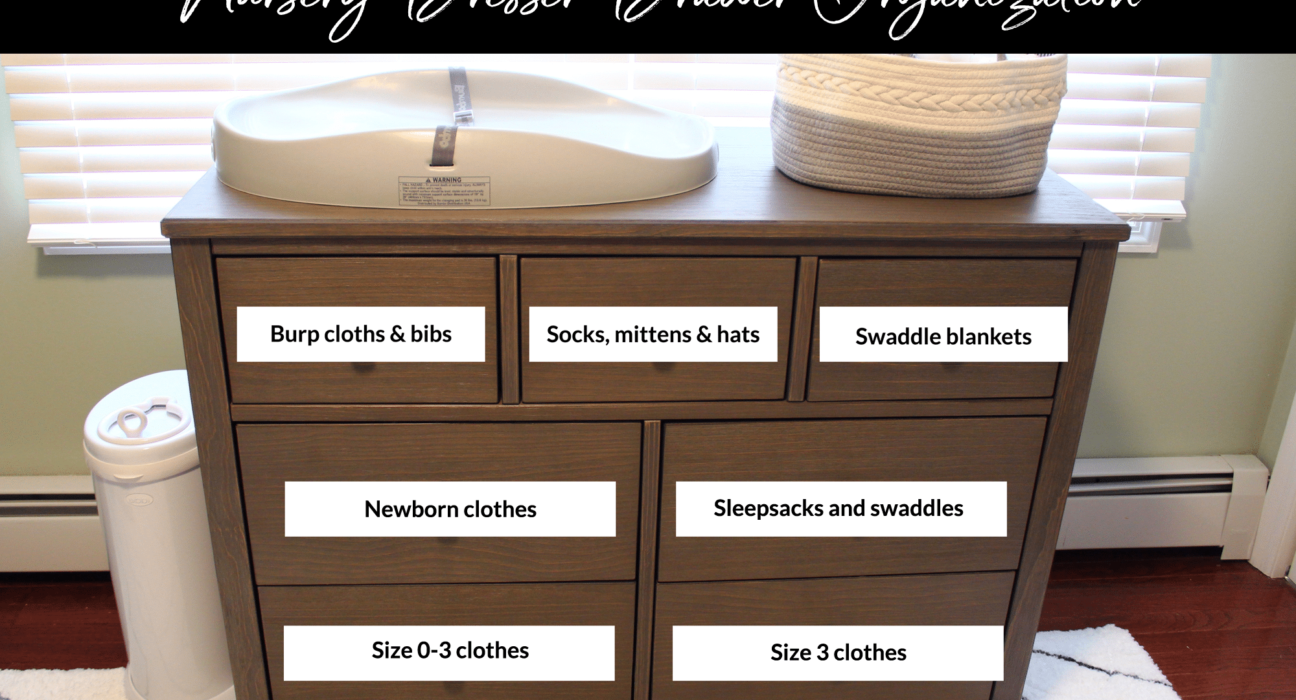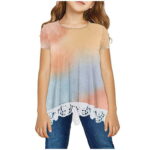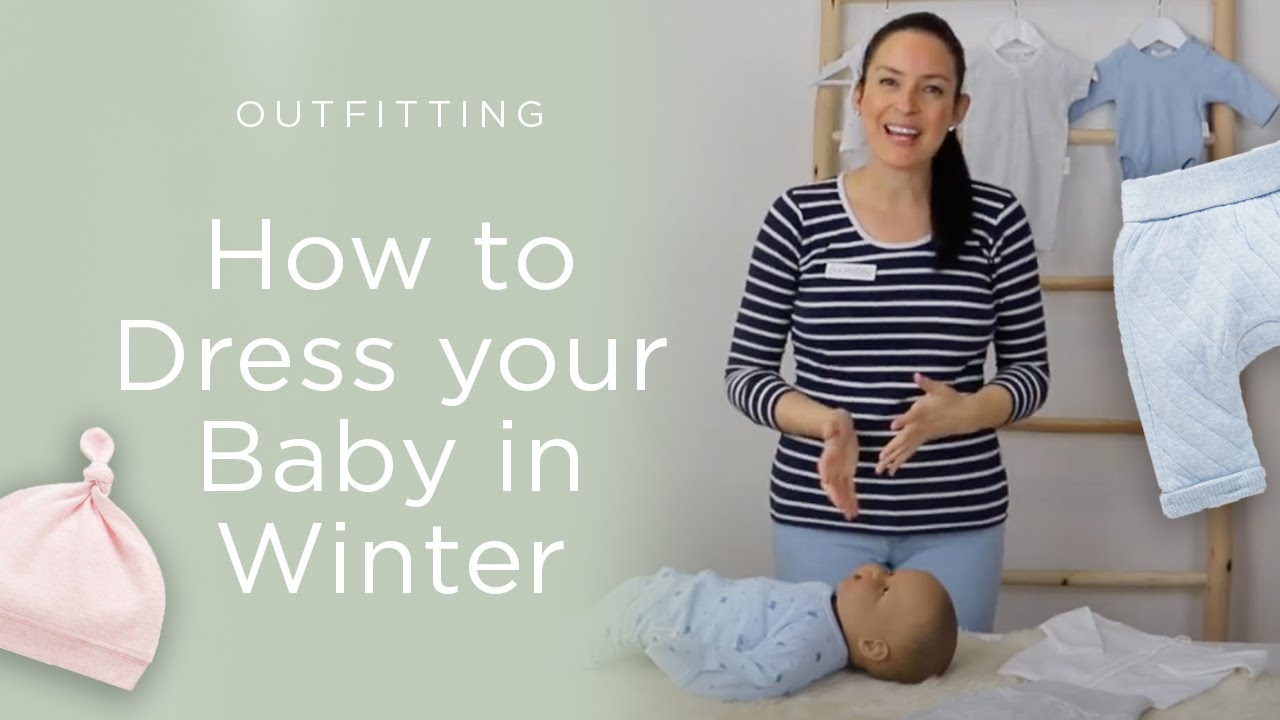To organize a newborn dresser, sort clothes by type and size. Use drawer dividers for easy access to essentials.
Welcoming a newborn into your home brings joy and excitement, but it also requires careful planning. A well-organized dresser can make daily routines smoother and less stressful. Newborns need frequent outfit changes, so easy access to their clothing is essential.
By categorizing items like onesies, sleep sacks, and bibs, you can streamline your dressing process. Consider using labels or color-coded bins to enhance organization. This not only saves time but also helps you quickly locate what you need. Creating a functional dresser setup ensures that both you and your baby enjoy a more relaxed and enjoyable experience at home.
Table of Contents
Introduction To Newborn Dresser Organization
Organizing a newborn dresser helps create a calm space. A tidy dresser makes finding baby clothes easy. It saves time during busy mornings or late-night changes. Let’s explore how to organize newborn dresser effectively.
The Importance Of An Organized Dresser
Keeping a newborn dresser organized is essential for several reasons:
- Efficiency: Quickly find clothing and supplies.
- Stress Reduction: A tidy space reduces chaos.
- Safety: Avoid clutter that can lead to accidents.
- Routine Building: Establish good habits for baby care.
Goals For Dresser Organization
Setting clear goals for your dresser organization is important. Consider these key objectives:
- Accessibility: Place frequently used items at eye level.
- Categorization: Group similar items together for easy access.
- Labeling: Use labels to identify drawers and sections.
- Space Optimization: Maximize space with organizers and bins.
| Category | Items to Include |
|---|---|
| Clothing | Bodysuits, Sleepers, Socks |
| Diapering | Diapers, Wipes, Creams |
| Accessories | Hats, Mittens, Bibs |
| Feeding | Bottles, Burp Cloths, Bibs |
Preparation Before Organizing
Organizing a newborn dresser requires careful preparation. This ensures everything is efficient and easy to access. Start by gathering supplies and assessing your storage space.
Gathering Necessary Supplies
Before organizing, collect all needed supplies. This will help streamline the process. Here are some essential items:
- Drawer dividers
- Storage bins
- Labels
- Cleaning supplies
- Measuring tape
Use drawer dividers to separate clothes. Storage bins hold extra items. Labels help identify each section easily.
Assessing Storage Space
Examine the dresser and available storage space. Understanding the layout is crucial. Follow these steps:
- Measure the dresser’s dimensions.
- Check the number of drawers.
- Look for any unused spaces.
Make a list of what fits where. Note the size of clothes and items. This will help you plan effectively.
Sorting Newborn Clothing
Sorting newborn clothing helps keep everything organized. It makes dressing your baby easier and quicker. A well-organized dresser saves time and reduces stress.
Categorizing By Item Type
Start by grouping clothes into categories. Here are some common categories:
- Bodysuits: These are essential for everyday wear.
- Sleepers: Perfect for bedtime and naptime.
- Outfits: Great for special occasions.
- Socks and Booties: Keep those little feet warm.
- Hats: Useful for sun protection or warmth.
Use bins or drawers for each category. Label each section clearly. This way, you can find items quickly.
Considering Baby’s Growth
Babies grow fast. It’s important to plan for this. Sort clothes by size to help you manage growth. Here’s a simple size guide:
| Size | Age Range |
|---|---|
| Newborn | 0-1 month |
| 0-3 months | 1-3 months |
| 3-6 months | 3-6 months |
| 6-9 months | 6-9 months |
| 9-12 months | 9-12 months |
Store outgrown clothes in bins. Keep them for future siblings or donate. This keeps the dresser neat and ready for new sizes.
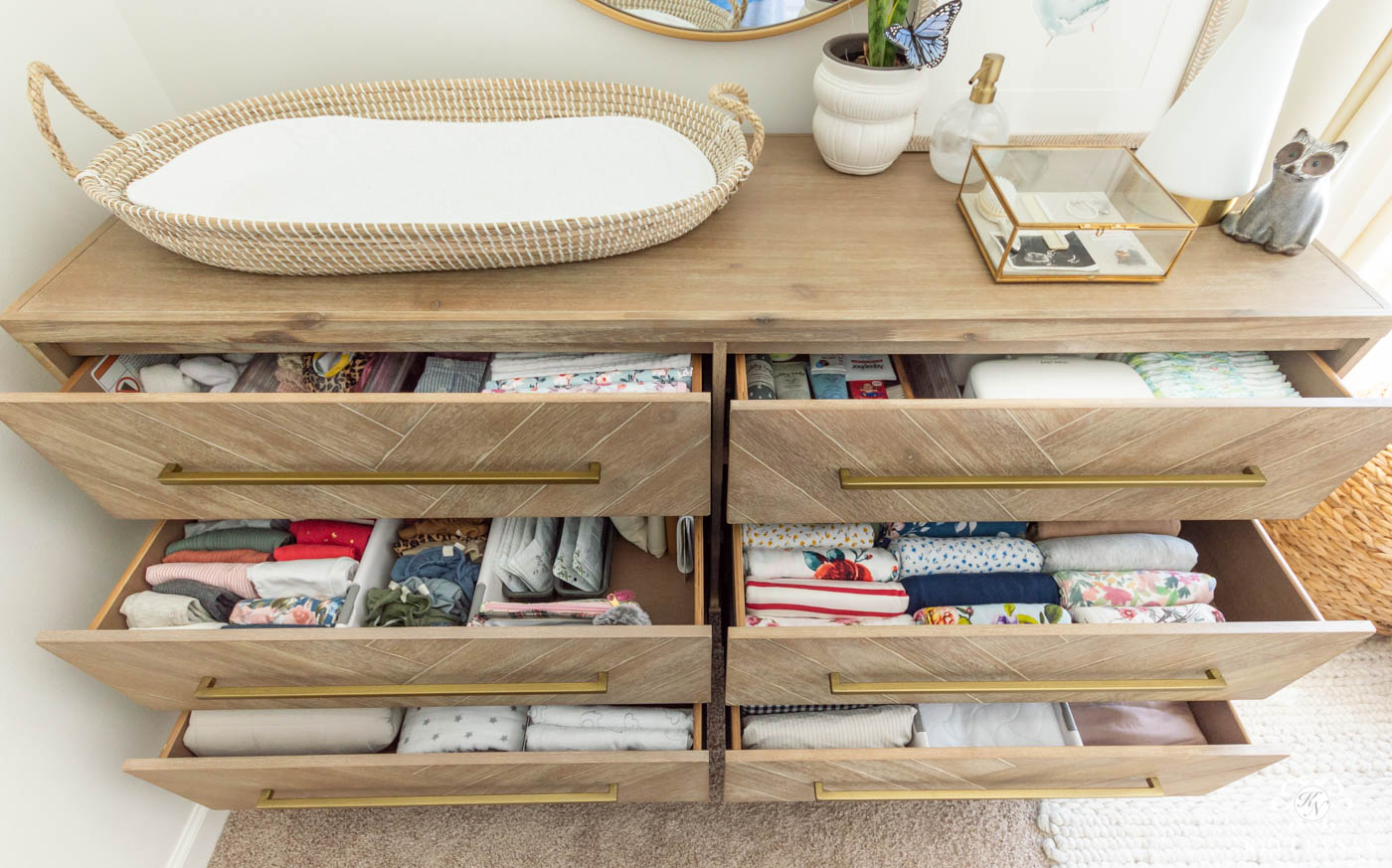
Credit: kelleynan.com
Folding Techniques For Small Clothes
Organizing a newborn’s dresser can be fun and rewarding. Proper folding techniques save space. They also make it easy to find clothes quickly. Here are two popular methods to help you.
The Konmari Method For Baby Clothes
The KonMari Method is simple and effective. It emphasizes joy and organization. Here’s how to use it for baby clothes:
- Gather all baby clothes in one place.
- Sort clothes by type: onesies, pants, and socks.
- Pick up each item. Ask, “Does this spark joy?”
- Fold clothes into small rectangles.
- Store them upright in the dresser.
This method makes it easy to see all clothes. It also keeps the dresser neat. You’ll enjoy dressing your baby even more!
Traditional Folding Methods
Traditional folding methods are time-tested. They work well for various types of clothes. Here are some techniques:
| Clothing Type | Folding Technique |
|---|---|
| Onesies | Fold in half, then roll from the bottom. |
| Pants | Fold in half lengthwise, then fold in thirds. |
| Socks | Lay one sock on top of the other, then roll. |
These techniques save space. They also help keep items wrinkle-free. Organizing clothes this way will keep everything tidy.
Try these folding methods. Enjoy the neatness and ease of finding baby clothes!
Drawer Division Strategy
Organizing a newborn dresser can be easy and fun. A good drawer division strategy helps find items quickly. It saves time and reduces stress. Here’s how to organize your dresser efficiently.
Using Drawer Organizers
Drawer organizers are handy tools. They keep everything in its place. You can buy them or make your own. Here are some options:
- Plastic bins
- Fabric dividers
- Small boxes
Place organizers in each drawer. This creates sections for different items. Label each section for easy access.
Designating Drawers For Categories
Assign specific drawers for each category. This method makes it easy to find clothes and essentials. Here’s a simple way to categorize:
| Drawer | Category |
|---|---|
| Top Drawer | Onesies and Bodysuits |
| Middle Drawer | Sleepers and Pajamas |
| Bottom Drawer | Socks and Hats |
Consider using a separate drawer for essentials. Diapers, wipes, and lotions fit well here. This setup makes changing time smooth and quick.
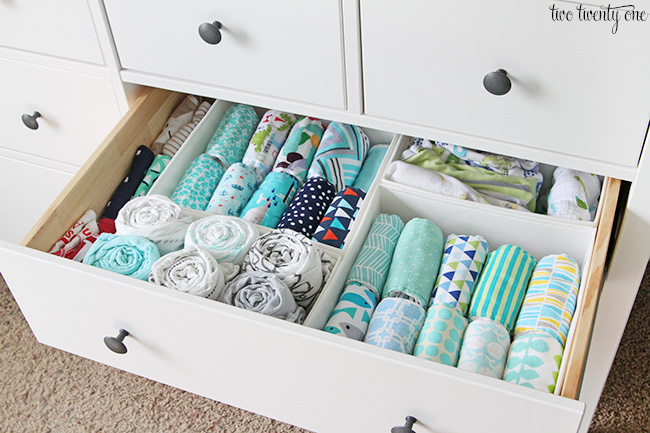
Credit: www.twotwentyone.net
Hanging Vs. Folding
Choosing between hanging and folding baby clothes can be tricky. Each method has its benefits. Understanding these can help you organize your newborn’s dresser better. Let’s explore the best options.
When To Hang Baby Clothes
Hanging clothes keeps them wrinkle-free. Use this method for:
- Delicate items: Dresses and special outfits.
- Frequently used: Everyday bodysuits and sleepwear.
- Seasonal items: Clothes for the current season.
Consider using matching hangers. They save space and look nice.
Hang clothes at a height your baby can’t reach. This keeps them safe.
Maximizing Space With Folding
Folding clothes is efficient. It saves space in drawers. Here’s how to fold effectively:
- Use the Marie Kondo method for easy visibility.
- Stack clothes by size and type.
- Label drawers for quick access.
Folding also protects clothes from dust. Use these tips for better organization:
| Type of Clothing | Folding Method | Benefits |
|---|---|---|
| Bodysuits | Fold and stack vertically | Easy to see and grab |
| Pants | Fold in half, then roll | Saves space and prevents wrinkles |
| Socks | Pair and fold | Prevents loss and keeps pairs together |
Use drawer dividers. They help separate items neatly.
Labeling For Convenience
Labeling makes organizing a newborn dresser easier. It helps you find items quickly. With clear labels, you can save time during busy days. Let’s explore effective labeling methods.
Creating Easy-to-read Labels
Easy-to-read labels are key for organization. Here are some tips:
- Use Large Fonts: Choose a font size that is easy to read.
- Simple Words: Use clear and simple terms.
- Durable Materials: Use sturdy labels that won’t tear easily.
- Consistent Style: Keep a uniform style for all labels.
Consider using a label maker. This tool creates neat, uniform labels. Handwritten labels can work too. Just ensure they are legible.
Color Coding For Quick Identification
Color coding adds another layer of organization. Different colors can represent different items. Here’s how to implement it:
| Item Type | Color Code |
|---|---|
| Onesies | Blue |
| Socks | Red |
| Hats | Green |
| Blankets | Yellow |
This system allows quick identification. You can grab items without searching. Color coding works well with your easy-to-read labels.
Top Drawer Essentials
Organizing your newborn’s dresser can make daily tasks easier. The top drawer holds the essentials. Keep frequently used items within easy reach. This helps save time and reduces stress.
Items To Keep At Arm’s Reach
- Diapers: Keep a supply of clean diapers.
- Wipes: Store a pack of baby wipes for quick clean-ups.
- Onesies: Have 3-5 easy-to-change outfits ready.
- Burp Cloths: Keep burp cloths handy for feeding times.
- Blankets: Include lightweight blankets for swaddling.
Organizing For Everyday Use
Use bins or dividers to keep items organized. Label each bin for easy identification. This system helps during nighttime changes.
| Item | Quantity | Location |
|---|---|---|
| Diapers | 10-12 | Top drawer |
| Wipes | 1 pack | Top drawer |
| Onesies | 3-5 | Top drawer |
| Burp Cloths | 3-4 | Top drawer |
| Blankets | 2-3 | Top drawer |
Keep the most essential items in front. This makes it easy to find what you need. Organizing creates a calm environment for you and your baby.
Seasonal Clothing Storage
Organizing a newborn dresser can be a fun task. Seasonal clothing storage helps keep your baby’s outfits neat. It makes dressing easier for you and comfortable for your baby.
Rotating Outfits By Season
Rotate your baby’s clothes based on the season. This method saves time and keeps everything organized.
- Spring: Light jackets, short sleeves, and breathable fabrics.
- Summer: Lightweight outfits, shorts, and sun hats.
- Fall: Long sleeves, warmer layers, and cozy sweaters.
- Winter: Heavy coats, snug hats, and warm booties.
Use a simple system to rotate outfits:
- Gather all seasonal clothes.
- Sort into piles by season.
- Store off-season clothes away.
- Display current season clothes at the top.
Storing Off-season Clothing
Storing off-season clothing properly keeps it in good condition. Follow these steps for effective storage:
| Storage Method | Description |
|---|---|
| Plastic Bins | Use airtight bins to keep clothes safe from moisture. |
| Vacuum Bags | Compress clothes for space-saving storage. |
| Labeling | Clearly label bins with sizes and seasons. |
Choose a cool, dry place for storage. Avoid direct sunlight and humidity. Check stored items regularly for any damage.
Maintaining Dresser Organization
Keeping your newborn’s dresser organized is essential. A tidy dresser makes finding items easier. It saves time during those busy mornings. Establishing a routine helps maintain organization.
Daily Habits For Order
Incorporate simple habits into your daily routine. These habits will keep the dresser neat.
- Make a Quick Check: Look at the dresser each morning.
- Put Away Clothes: After dressing your baby, return clothes to the right spot.
- Reset the Space: Every evening, tidy up any mess.
Use labeled bins for easy identification. Group similar items together. For example, keep all socks in one bin.
Weekly Check-ins And Adjustments
Schedule a weekly dresser check-up. This helps catch any messes before they grow.
- Inspect Each Drawer: Open each drawer and look inside.
- Remove Unused Items: Take out clothes your baby has outgrown.
- Reorganize as Needed: Change the layout if items don’t fit well.
Use a table to track your weekly tasks:
| Day | Task |
|---|---|
| Monday | Check for any clutter |
| Wednesday | Sort out outgrown clothes |
| Friday | Reorganize drawers if needed |
These simple practices keep your newborn’s dresser organized. A well-maintained dresser helps you stay stress-free.
Safety Considerations
Organizing a newborn dresser involves important safety measures. Ensuring a safe environment protects your baby from potential hazards. Here are two key areas to focus on.
Securing The Dresser
Stability is crucial for your baby’s safety. Follow these steps to secure the dresser:
- Use anti-tip furniture straps.
- Anchor the dresser to the wall.
- Avoid heavy items on top of the dresser.
These actions prevent tipping and falling. Always check the stability of the dresser regularly.
Safe Access To Clothing
Make it easy and safe for you to access clothing. Here are some tips:
- Place frequently used items at waist level.
- Store heavier clothes in lower drawers.
- Keep sharp objects away from baby’s reach.
Label drawers to help you find items quickly. Use soft-close drawers to avoid pinched fingers.
Space-saving Tips
Organizing a newborn’s dresser can be a fun challenge. Use these space-saving tips to maximize storage. Create a neat, functional space for baby essentials.
Utilizing Vertical Space
Vertical space is often underused. Make the most of it with these ideas:
- Stackable Bins: Use clear bins to stack clothes and accessories.
- Hanging Organizers: Hang organizers on the inside of the dresser door.
- Wall Shelves: Install shelves above the dresser for extra storage.
These options free up drawer space. They also make items easy to find.
Multipurpose Items
Choose multipurpose items for efficiency. They save space and money. Consider these examples:
| Item | Function |
|---|---|
| Changing Pad: | Can double as a soft surface for playtime. |
| Storage Baskets: | Hold toys and clothes while looking stylish. |
| Dresser with Changing Top: | Acts as both dresser and changing station. |
Multipurpose items optimize space effectively. They keep everything organized.
Integrating Decor And Functionality
Organizing a newborn dresser can be both fun and practical. Combining aesthetics with functionality creates a soothing environment. A well-organized dresser enhances the nursery’s look while making essentials easy to find.
Aesthetically Pleasing Arrangements
Creating a beautiful dresser setup involves simple steps. Here are some tips:
- Color Coordination: Use matching colors for clothes and accessories.
- Vertical Space: Stack items to save space and add height.
- Natural Elements: Incorporate plants or wood accents for warmth.
Use decorative baskets to hold smaller items. Choose baskets that match the nursery theme. This keeps things tidy and visually appealing.
Organizers That Complement Decor
Choosing the right organizers enhances both function and style. Consider these options:
| Organizer Type | Benefits | Style Tips |
|---|---|---|
| Drawer Dividers | Keep items separated and easily accessible. | Choose dividers in soft colors. |
| Stackable Bins | Maximize vertical storage space. | Use clear bins to see contents easily. |
| Hanging Organizers | Free up drawer space for larger items. | Match the fabric with the nursery theme. |
Using stylish organizers makes everything look neat. Keep the dresser functional while adding to the decor.
When To Purge And Update
Keeping a newborn dresser organized requires regular updates. Babies grow quickly, and their needs change. Knowing when to purge old items helps maintain an efficient space.
Outgrowing Sizes
Newborns grow fast. Clothes quickly become too small. Monitor your baby’s growth every month.
- Check the size tags on clothing.
- Remove items that no longer fit.
- Store or donate outgrown clothing.
Keep only sizes your baby currently wears. This creates a clutter-free environment.
Seasonal Refreshes
Seasons change, and so do clothing needs. A seasonal refresh keeps essentials available.
- Assess the current season.
- Remove clothes unsuitable for the weather.
- Replace with appropriate seasonal items.
Store off-season clothes in bins. Label bins for easy access. This simple step makes future updates quick.
| Season | Clothing Types |
|---|---|
| Spring | Light jackets, onesies, shorts |
| Summer | Short sleeves, swimwear, breathable fabrics |
| Fall | Long sleeves, sweaters, pants |
| Winter | Coats, hats, warm socks |
Refresh your baby’s dresser every three months. This keeps it functional and organized.
Conclusion And Final Thoughts
Organizing a newborn dresser creates an efficient space for quick access to essentials. Prioritize items by frequency of use, ensuring everything is easily reachable. A well-organized dresser not only saves time but also enhances the overall nursery experience.
Reflecting On The Organizational Journey
Organizing a newborn dresser is rewarding. It creates a cozy space for your baby. Every item has its place. This makes daily tasks easier and faster.
Think back to how cluttered it felt. Now, everything is neat and accessible. Enjoy the satisfaction of a well-organized dresser. It not only helps you but also brings peace of mind.
Encouragement For Upkeep
Keeping your newborn dresser organized is key. Regular upkeep saves time and stress. Here are some simple tips:
- Set a weekly schedule for organizing.
- Check for outgrown clothes regularly.
- Keep a donation bin nearby for unused items.
Make it a family activity. Involve older siblings in the process. Teach them the value of organization.
Use this table for quick reference:
| Tip | Benefit |
|---|---|
| Weekly organizing | Prevents clutter build-up |
| Check for outgrown clothes | Keeps dresser functional |
| Involve family members | Promotes teamwork |
Stay consistent with these practices. Your newborn dresser will remain a serene space. Enjoy every moment with your little one.
:max_bytes(150000):strip_icc()/David_Casas_6-162fb7582ad4471b90a81f5f8a212d63.jpeg)
Credit: www.thespruce.com
Frequently Asked Questions
How Should I Organize A Newborn Dresser?
Sort clothes by type and size. Use drawer dividers for easy access and label sections for clarity.
What Items To Keep In A Newborn Dresser?
Include onesies, pajamas, socks, and hats. Store swaddles and burp cloths in easy-to-reach sections.
How To Maximize Space In A Newborn Dresser?
Use vertical space with stackable organizers. Fold clothes neatly and roll items to save room.
What’s The Best Way To Fold Baby Clothes?
Try the Marie Kondo method. Fold clothes vertically for visibility and easy access to each item.
How Often Should I Reorganize The Dresser?
Reorganize every few months or as your baby grows. Regularly assess clothing sizes and seasonal needs.
Conclusion
Organizing a newborn dresser can simplify your daily routine. Keep essentials within reach to save time and reduce stress. Use labeled bins to enhance visibility and ease of access. A well-organized dresser not only looks appealing but also makes dressing your baby a breeze.
Start today for a more efficient nursery.



